Publication
Video
Supplements and Featured Publications
Future Perspectives in Higher-Risk MDS
Author(s):
Dr Gustavo Rivero comments on novel treatment combinations and potential new biomarkers in patients with MDS.
Gustavo Rivero, MD: For a case of high-risk myelodysplastic syndrome [MDS], what are the newer medications that are on the table that might be very, very attractive? I would like to categorize this into 3 domains. The first domain is immune checkpoint inhibitors. Among them, we are paying significant attention to TIM-3 in combination with azacitidine. As you might remember, the combination has been associated with an overall response rate of 59% vs a single-agent HMA [hypomethylating agent] with a rate of about 42%. So the duration of response and the 1-year disease-free survival was 59% for the TIM3 inhibitor vs 32% for a single-agent HMA. So this is something that we should keep in mind for the case of TP53 [-mutated] MDS, even though the medication was paused recently by the FDA [United States Food and Drug Administration], we have a reactivation of enhanced 2 and 3. This will be for the medication magrolimab, which is a monoclonal antibody against CD47. CD47 is ubiquitously expressed in hematopoietic progenitors, and it's a molecule that might induce inhibition of prophagocytic activity by using the monoclonal antibody profile phagocytic activity increase stated, and it's preferentially observed among a subgroup of patients with TP53-MDS. So we're paying significant attention to immune checkpoint inhibitors. And then I would like to move to the second domain which is the combination of azacitidine plus venetoclax, we have shown impressive responses, achieving almost 78% for high-risk MDS with excellent and durable remissions. The third domain would be the specific attention we should keep concerning those patients with high-risk MDS that are overexpressing RARA. As I mentioned before, almost 59% of these patients might upregulate RARA via super-enhancers. They've created an excellent biologic rationale for combination with HMA, and we will be paying attention to these 3 domains.
There will be a necessity—an urgent necessity, a biologic necessity—to understand biomarkers that respond to certain novel medications and biomarkers of durable response in high-risk MDS. So in regard to responses, I mentioned before that with the ability of immunophenotypic classification of MDS—whether or not we are going to be able to classify high-risk MDS in common myeloid progenitor-like disease or granulosa monocytic like-disease—we will be able to segregate a suitable patient that might be over expressing RARA. If that is the situation, then preferentially, we will derive or we will treat our patient with a combination of azacitidine and the RARAinhibitor. This is in the case that, potentially, we have a beneficial signal for the combination. So monocytic-like progenitors, AML [acute myeloid leukemia] have been associated with poorer responses to azacitidine and venetoclax, which I suspect will be the same situation for those patients with high-risk MDS. So phenotypic classification as a biomarker is emerging, and I'm expecting widespread use of this technology to better categorize the type of responses that we can have, to novel combinations of therapy. In regard to genomics, having P53 as an MDS-like disease should brand potentially, the possibility that immune checkpoint activation might be happening; therefore potentially using magrolimab in this setting might be beneficial.
Transcript edited for clarity.










